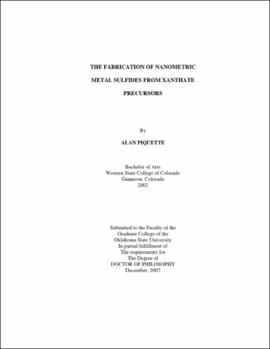| dc.contributor.advisor | Apblett, Allen | |
| dc.contributor.author | Piquette, Alan | |
| dc.date.accessioned | 2013-11-26T08:21:29Z | |
| dc.date.available | 2013-11-26T08:21:29Z | |
| dc.date.issued | 2007-12 | |
| dc.identifier.uri | https://hdl.handle.net/11244/6471 | |
| dc.description.abstract | Scope and Method of Study: The objective of this research was the development of new chemical routes for the synthesis of nanoscale metal sulfides and metal oxides. This was accomplished by investigating a family of materials known as xanthates. It was determined that metal xanthates were ideal single-source precursors for both target products. A wide variety of metal centers and alkyl substituents were easily incorporated into xanthate species yielding new precursors with tunable properties. A systematic characterization of the various precursors by means of thermogravimetric analysis indicated that the decomposition temperatures required to convert the xanthates into nanometric sulfides is lower than that of any other known single precursor. Detailed analyses were performed on both the precursors and the sulfides/oxides using such tools as powder X-ray diffraction, electron microscopy, and nitrogen adsorption surface area analysis along with infrared, Raman, ultraviolet-visible, fluorescence, X-ray fluorescence, and atomic absorption spectroscopies. Two major goals were envisioned: develop metal sulfide and metal oxide materials with enhanced, tunable electrical and optical properties, and fabricate high surface area metal sulfide and/or metal oxide adsorbents for remediation of harmful contaminants in drinking water. | |
| dc.description.abstract | Findings and Conclusions: Metal sulfide and metal oxide nanoparticles were obtained from different xanthate-based precursors possessing distinctive properties such as ultra high surface area and intense emissivity. For example, zinc sulfide, with the largest specific surface area reported to date (> 350 m^2 g^-1), can be synthesized in a solvent-free, additive-free environment simply by heating zinc ethylxanthate to 125C. Cadmium, copper, silver, nickel, zinc, and other metal sulfide quantum dots were easily prepared in aqueous solution with little or no external stabilizing agents required since the thermal decomposition byproducts of the xanthates act as capping agents. The xanthate precursors can also be used to prepare ternary sulfides such as CuInS2 and CuIn1-xGaxS2. A number of other beneficial materials such as mirror-like thin-films of metallic NiS, conductive polymers, and efficient water purification adsorbents were successfully synthesized. Succinctly, metal xanthate complexes are versatile compounds that can generate a wide array of useful metal sulfide and metal oxide semiconductor nanoparticles. | |
| dc.format | application/pdf | |
| dc.language | en_US | |
| dc.rights | Copyright is held by the author who has granted the Oklahoma State University Library the non-exclusive right to share this material in its institutional repository. Contact Digital Library Services at lib-dls@okstate.edu or 405-744-9161 for the permission policy on the use, reproduction or distribution of this material. | |
| dc.title | Fabrication of nanometric metal sulfides from xanthate precursors | |
| dc.contributor.committeeMember | Materer, Nicholas | |
| dc.contributor.committeeMember | Slaughter, LeGrande | |
| dc.contributor.committeeMember | Smay, Jim | |
| osu.filename | Piquette_okstate_0664D_2562.pdf | |
| osu.accesstype | Open Access | |
| dc.type.genre | Dissertation | |
| dc.type.material | Text | |
| dc.subject.keywords | xanthate | |
| dc.subject.keywords | nanoparticles | |
| dc.subject.keywords | metal sulfide | |
| dc.subject.keywords | high surface area | |
| thesis.degree.discipline | Chemistry | |
| thesis.degree.grantor | Oklahoma State University | |
